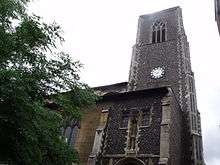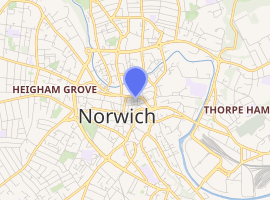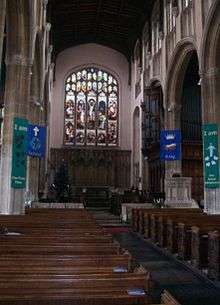St Andrew's Church, Norwich
St Andrew's Church, Norwich is a Grade I listed medieval building in Norwich.[1]
| St Andrew's Church, Norwich | |
|---|---|
 St Andrew's Church, Norwich | |

| |
| 52°37′49″N 1°17′43″E | |
| Location | Norwich, Norfolk |
| Country | England |
| Denomination | Church of England |
| Churchmanship | Evangelical |
| History | |
| Dedication | St Andrew |
| Architecture | |
| Heritage designation | Grade I listed |
| Administration | |
| Parish | St Andrew’s Norwich |
| Deanery | Norwich East |
| Archdeaconry | Norwich |
| Diocese | Anglican Diocese of Norwich |
| Province | Province of Canterbury |
History
Saint Andrew's is a fine example of a hall church. In late Perpendicular Gothic style with a timber roof of tie beam construction, it is the second largest church in Norwich, and one of the last medieval churches to be built in the city. The main body of the church dates from 1499 to 1518. The tower dates from 1498, the south porch from c.1469 and the north porch from c. 1474.
After the Reformation St Andrew’s became a preaching house for the new 'Protestant' religion. In August 1603 John Robinson (1576 - 1625) became associate pastor of St. Andrew's Church. Norwich at this time, had strong links with Holland and Flanders. It was the home to a considerable number of foreign workers and refugees and its most influential political leaders and merchants were Puritans. Robinson was one of the founders of the Congregational church and later became pastor to the Pilgrim Fathers before their emigration to the New World.
Main dates
- 1386 Bequests made to a church on this site
 Interior of Saint Andrew's church, NorwichAlabaster monument (circa 1611) to Sir John Suckling (politician)
Interior of Saint Andrew's church, NorwichAlabaster monument (circa 1611) to Sir John Suckling (politician) - 1478 West tower under construction
- c.1496 Work on West tower completed
- 1506 Work completed on the nave and chancel, replacing the previous structure
- 1557 Elizabeth Cooper, wife of a pewterer, burned as a heretic. Foxe's Book of Martyrs
- 1607 Churchwardens excommunicated for installing special seating for local dignitaries
- 1637 Font cover produced
- 1867 Major restoration work undertaken including new pews, pulpit and stone screen
- 1878 Font replaced
- 1908 Organ case installed
Memorials
There are monuments to:
- Robert Suckling (d. 1589)
- Francis Rugg (d. 1607)
- Robert Garsett (d. 1613)
- Sir John Suckling (politician) (d. 1627)
- Dr. Thomas Crowe (d. 1751) by Robert Page
- John Custance (d. 1752) by Thomas Rawlins
- Hambleton Custance (d. 1757) by Thomas Rawlins
- Richard Dennison (d. 1768) by Thomas Rawlins
Also interred at the church are silversmith Arthur Haselwood II and his wife, Elizabeth, herself also a silversmith.[2]
Organ
The church contained an organ dating from 1808. The current organ case was installed in 1908. A specification of the organ can be found on the National Pipe Organ Register.[3]
References
- The Buildings of England. Norfolk. Nikolaus Pevsner. p.235. First Edition. 1962. Penguin Books Limited
- Carol Twinch (29 February 2012). Norwich Book of Days. History Press. pp. 133–. ISBN 978-0-7524-8607-9.
- "NPOR A00061". National Pipe Organ Register. British Institute of Organ Studies. Retrieved 2 February 2015.